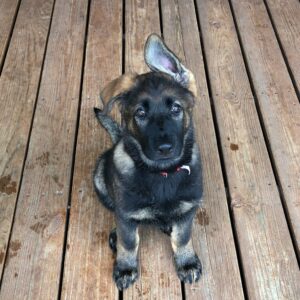Table of Contents
The Ultimate Guide for New Puppy Owners and Dog Lovers
Bringing home a new puppy is an exhilarating experience. Their boundless energy, playful antics, and unwavering excitement are infectious. However, one behavior that’s less delightful is the infamous puppy biting. While those razor-sharp baby teeth are a natural part of your pup’s growth, they can cause quite the discomfort. How do you stop puppy biting?
We’re about to explore ten strategies that not only curb your pup’s biting, but also lay the foundation for a well-mannered dog. This post aims to help you as a new puppy owner understand and address the common issue of puppy biting using humane and effective techniques.
Understanding Puppy Biting
Puppies explore the world with their mouths, much like human babies. Biting is instinctual, natural, and also a means of communication within the litter. When they come home with you, this behavior doesn’t simply stop. It’s up to you to show them where the line is, and the earlier you begin, the easier it is to train your pup for a happy, bite-free adulthood. Dogs have many perfectly natural behaviors. Responsible owners have to teach boundaries around to make them good members of our family.
Strategy 1: Redirect Biting to Toys
The first thing to do when your puppy starts to nibble is to give them a suitable alternative to your hands, feet, and clothing. Make chew toys available in multiple locations to foster a chewing habit that doesn’t involve you. This was the best tactic to use with Jasper. I should have bought stock in bully sticks!
If you have children, be sure to teach them to keep a bully stick or toy in their hand while playing. It’s much like your two year old toddler, distract and redirect until they grow out of it!
Strategy 2: Use Positive Reinforcement
Each time your puppy plays gently or with a toy instead of biting, reward that good behavior. Use high-value treats and plenty of praise to reinforce the positive change.
Use this trick to teach your puppy to take treats gently. Hold the treat in your hand with your hand closed until the puppy stops trying to get to the treat. Then open your hand. If he tries to get the treat ,simply close your hand again. Once he is politely waiting, tell him OK and let him get the treat. Pretty soon, he will understand waiting nicely for his treat will get him better results.
Strategy 3: Implement ‘Time-Outs’
If your pup bites particularly hard, it’s crucial to teach them that overdoing it means the fun stops. Yip or say ‘ouch’ to mimic the sound of another puppy in pain, then withdraw attention for about 30 seconds. Be consistent; it won’t take long for them to understand that biting too hard leads to a pause in play. This should be done in a very matter-of-fact way. Remember, you are not “punishing” your puppy, you are teaching him boundaries.
Strategy 4: Socialize Your Puppy
Puppies learn bite inhibition by playing with other dogs. Regular and positive interaction with vaccinated, friendly, and patient adult dogs can help in this aspect. However, do not take your puppy around dogs you do not know. Vet the dogs carefully. A negative experience is worse than no experience. Keep in mind, the most important relationship to build is the one with you. You do not want your dog to prefer any interaction over his interaction with you. With Jasper’s reactivity, my goal is not to have him play with other dogs. It’s to have him look at other dogs as uninteresting or with no reaction/reactivity.
Strategy 5: Discourage Rough Play
Certain games, like tug-of-war, can encourage rough play and may be better avoided if biting is an issue. Choose calm playtime activities instead, such as fetching or hide-and-seek with treats. Later, when your little alligator calms down, you can try tug.
Strategy 6: Use Bitter Sprays on Hands
Bitter apple or other taste deterrent sprays can be a useful tool. Apply this on your hands, feet, and clothes when your puppy is likely to be tempted to bite.
This may work, but since I tend to unconsciously bite my nails, it would likely be worse on me than Jasper! I can see where it might be very helpful on children’s ankles, since GSD love to herd by nipping.
Strategy 7: Teach Command ‘Leave It’
Developing this command is a game-changer. By teaching your puppy to ‘leave it’, you give yourself an instant way to stop them from biting things they shouldn’t. It can also be life saving if your dog goes for something that could hurt him.
Strategy 8: Keep Your Puppy Tired
“A tired puppy is a good puppy.” Make sure they have enough regular exercise and mental stimulation. If boredom is the cause, plenty of toys and playtime can do wonders. There are a few “couch potatoes” breeds out there but GSD are not one! Almost all working breeds will need regular exercise.
Strategy 9: Consult a Professional
Sometimes, despite our best efforts, puppy biting can persist in more aggressive forms. Don’t hesitate to seek the guidance of a professional trainer to address these issues head-on. Do be careful who you use. Anyone can claim they are a trainer.
Strategy 10: Practice Patience and Consistency
Above all, remember that training takes time and a consistent approach. Be patient and keep at it—your persistence will pay off, and the bond with your pup will grow stronger through the training process.
My experience with Jasper was that this behavior faded by 7 or 8 months. He rarely mouths me now, and if he does, I correct him and sub a toy as Jasper has very big teeth! Using them on me is not, even in play, something I do not want to encourage.
Conclusion
By implementing these strategies, you are not only addressing the immediate biting habit but also laying down the groundwork for a harmonious relationship built on trust and effective communication. Puppyhood is a crucial time to shape behaviors that will last a lifetime. Be proactive, be patient, and enjoy the process of turning your little biter into a well-mannered companion.


